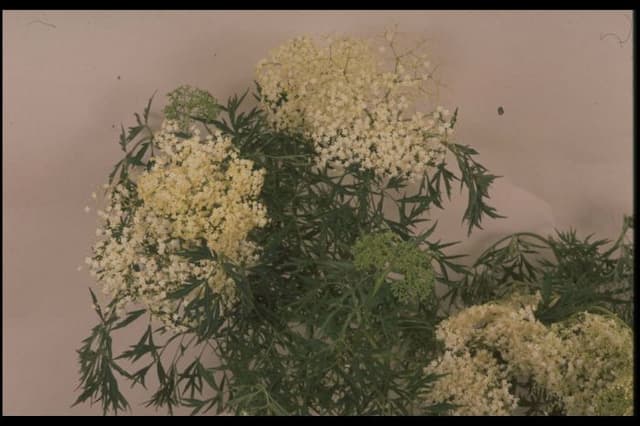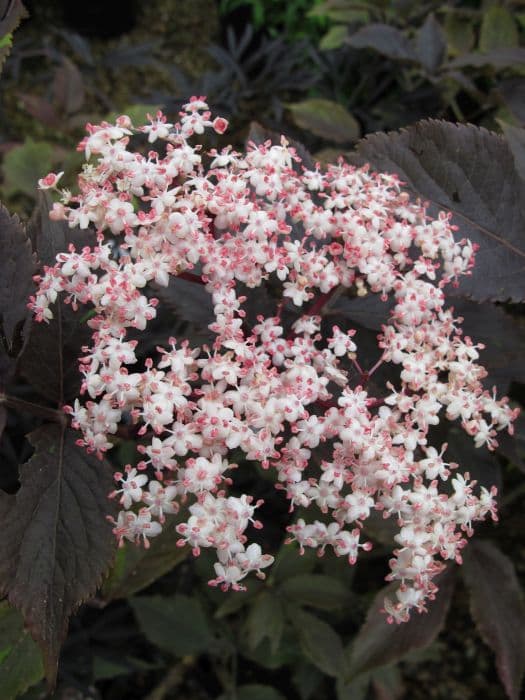Japanese Snowball Viburnum plicatum f. tomentosum Kilimanjaro = 'Jww1' (PBR)
![Japanese snowball [Kilimanjaro]](/_next/image?url=https%3A%2F%2Fplants-admin.emdemapps.com%2Fimages%2Fplants%2F%2Fimages%2F604b5851f3cdb.png&w=3840&q=75)
ABOUT
The plant known as Viburnum Kilimanjaro has a distinctive layered, pyramidal shape, resembling a narrow, multi-tiered wedding cake. It is adorned with branching that produces horizontal tiers, giving it a well-structured and elegant appearance. During spring, Kilimanjaro is celebrated for its beautiful flowers which appear in abundant, lacecap-style clusters that are flat-topped and consist of tiny, fertile blooms ringed by larger, infertile flowers. These blossoms are initially a greenish color, transforming into bright white as they mature, providing a striking contrast against the dark green leaves. In fall, the foliage undergoes a magnificent change, sporting shades of red and purple which add a dramatic flair to the garden landscape. After the flowering period, the plant produces berries. The berries initially have a red hue and gradually darken to a black tone as they ripen. These fruits are attractive to birds and other wildlife, making the Kilimanjaro a haven for nature watchers. The leaves of this plant are equally impressive, being deeply veined with a pleated texture and an ovate shape, which exhibit a lush green color throughout the growing season. The plant is deciduous, meaning it sheds its leaves annually. The overall impression of the Kilimanjaro is one of a refined and decorative shrub with a distinct tiered habit, attractive in all seasons whether because of its spring blossoms, fall coloration, or pleasing structure even when the branches are bare.
About this plant
 Names
NamesSynonyms
Kilimanjaro Viburnum, Kilimanjaro Japanese Snowball, Kilimanjaro Doublefile Viburnum.
Common names
Viburnum plicatum var. tomentosum.
 Toxicity
ToxicityTo humans
The plant known as Japanese Snowball is generally not considered toxic to humans. In most cases, it does not pose a threat if touched or ingested in small quantities. However, as with many plants, individual reactions can vary and some people might experience mild gastrointestinal discomfort if they consume parts of the plant. There is no widespread documentation of severe toxicity in humans due to ingestion of the Japanese Snowball, but it's advisable to avoid eating any plant material that is not known to be edible.
To pets
The Japanese Snowball is not typically toxic to pets. It is considered a non-toxic plant for dogs and cats according to the ASPCA. While ingestion of plant material might sometimes cause mild stomach upset in pets, such as vomiting or diarrhea, the Japanese Snowball is not known for causing severe or life-threatening symptoms. It is always best to discourage pets from chewing on any plants to prevent any potential issues.
 Characteristics
CharacteristicsLife cycle
Perennials
Foliage type
Deciduous
Color of leaves
Green
Flower color
White
Height
8 feet 2.44 meters
Spread
6 feet 1.83 meters
Plant type
Shrub
Hardiness zones
5
Native area
Japan China
Benefits
 General Benefits
General Benefits- Ornamental Value: Kilimanjaro Viburnum provides year-round visual interest with its white, lace-cap flowers, red to black fruit, and attractive fall foliage.
- Wildlife Attraction: The berries produced by the plant attract birds and provide a food source for wildlife.
- Low Maintenance: Once established, Kilimanjaro Viburnum requires minimal care, making it suitable for gardeners of all skill levels.
- Drought Tolerance: This plant can tolerate periods of dryness once it has been established, reducing the need for frequent watering.
- Dense Growth Habit: The bushy, dense growth habit of Kilimanjaro Viburnum can serve as an excellent hedge or privacy screen.
- Seasonal Interest: The plant offers a variety of seasonal changes from flowers in spring, berries in summer and autumn, to textured leaves in winter.
- Suitable for Containers: Kilimanjaro Viburnum can be grown in containers, which makes it versatile for patios, balconies, and other confined spaces.
- Natural Boundary: The shrub's dense foliage can be used to define garden spaces or property lines naturally.
- Erosion Control: The root system of Kilimanjaro Viburnum can help stabilize soil and prevent erosion on slopes.
- Adaptable to Various Soils: The plant can thrive in a range of soil types, from clay to loam, as long as the soil is well-draining.
 Medical Properties
Medical PropertiesThis plant is not used for medical purposes.
 Air-purifying Qualities
Air-purifying QualitiesThis plant is not specifically known for air purifying qualities.
 Other Uses
Other Uses- Viburnum plicatum f. tomentosum Kilimanjaro, commonly known as Japanese Snowball, can be used in floral arrangements; its distinctive globular flower clusters add elegance and volume to bouquets.
- The branches of the Japanese Snowball may be incorporated into wreaths and other dried floral crafts, where they lend a touch of nature's beauty with their intricate branching patterns.
- The dense foliage of the Japanese Snowball is sometimes utilized in garden design for creating privacy screens or hedges, offering a living fence that adds a decorative element.
- Its strong structure allows the Japanese Snowball to be used in topiary art, giving gardeners the chance to shape this versatile plant into various ornamental forms.
- The Japanese Snowball's varied leaf colors throughout the seasons offer inspiration to artists and designers, influencing color palettes in various creative fields.
- Juvenile growth stems with their unique texture and hue could be harvested to be used in eco-fashion as natural buttons or embellishments for clothing.
- The wood of dead or pruned branches of the Japanese Snowball may serve in crafting small wooden objects like tool handles, owing to its moderate hardness.
- The somewhat symmetrical form of the Japanese Snowball plant itself can be used as a central piece in symmetry-focused garden designs and landscape art.
- Capture the aesthetic appeal of the Japanese Snowball by using photographs of its blooms in stock photography, especially appealing for spring and nature-themed imagery.
- Insect-friendly gardens can benefit from including the Japanese Snowball as it attracts pollinators, contributing to overall garden health through ecosystem support.
Interesting Facts
 Feng Shui
Feng ShuiThe Japanese Snowball is not used in Feng Shui practice.
 Zodiac Sign Compitability
Zodiac Sign CompitabilityThe Japanese Snowball is not used in astrology practice.
 Plant Symbolism
Plant Symbolism- Renewal: Viburnum blooms often in the spring, marking a new beginning and a sign of awakening nature.
- Purity: The white flowers of the Japanese Snowball are associated with cleanliness and innocence.
- Perseverance: This plant can thrive in various conditions, symbolizing the ability to persist through challenges.
- Beauty: With its beautiful, round, snowball-like flowers, the Japanese Snowball represents beauty and the aesthetic pleasures of nature.
- Interconnectedness: The layered branches and dense foliage are often seen as a symbol of our own interconnected lives and relationships.
 Water
WaterThe common name for Viburnum plicatum f. tomentosum 'Kilimanjaro' is Japanese Snowball. Water this plant deeply once a week during the growing season, ensuring that the soil is moist but not waterlogged. During hot, dry spells, you might need to water twice a week. Use about 1-2 gallons of water per session, depending on the size and maturity of the plant. In winter, reduce watering to every two to three weeks, or as needed, to prevent the soil from drying out completely.
 Light
LightJapanese Snowball thrives in a location with full sun to partial shade. Ideally, plant it where it will receive at least 4 to 6 hours of sunlight a day. The best spot would have morning sun and afternoon shade, especially in regions with hot summers, to prevent leaf scorch.
 Temperature
TemperatureJapanese Snowball is hardy and can tolerate a wide range of temperatures, but it grows best in areas with moderate temperatures. It can survive in temperatures as low as -10°F and as high as 95°F. However, the ideal temperature range for the Japanese Snowball is between 60°F and 80°F.
 Pruning
PruningPrune Japanese Snowball immediately after it finishes flowering to maintain its shape and size. This is typically done in late spring or early summer. Pruning not only helps to encourage new growth and improve the plant’s appearance but also allows for better air circulation. Remove any dead or damaged branches, and thin out dense growth to enhance the plant's form.
 Cleaning
CleaningAs needed
 Soil
SoilFor the Viburnum plicatum 'Kilimanjaro', the best soil mix is well-draining, fertile and loamy soil with added organic matter like compost or peat moss. It prefers a soil pH range of slightly acidic to neutral, around 5.6 to 7.0.
 Repotting
RepottingViburnum plicatum 'Kilimanjaro' is typically grown in the landscape and does not require regular repotting. In containers, young plants may be repotted every 2-3 years to encourage growth.
 Humidity & Misting
Humidity & MistingViburnum plicatum 'Kilimanjaro' grows best in average outdoor humidity levels. It does not have specific humidity requirements but thrives in the typical humidity found in its outdoor environment.
 Suitable locations
Suitable locationsIndoor
Ensure bright, indirect light and room to grow.
Outdoor
Plant in full sun to partial shade with space for mature size.
Hardiness zone
5-8 USDA
 Life cycle
Life cycleThe Japanese Snowball 'Kilimanjaro', begins its life cycle when a seed germinates, typically requiring a period of cold stratification to break dormancy. Once the seedling emerges, it enters a vegetative stage, where it focuses on root and foliage development. As the plant matures, it enters the flowering stage, usually in spring, producing large, lacecap-like white flowers that attract pollinators. After pollination, it may produce fruits, which are drupes that turn from red to black when ripe, and are often consumed by birds that then disperse the seeds. Following this reproductive phase, the plant enters a period of senescence during the colder months, experiencing a dormancy that helps it survive winter conditions. Each spring, the plant breaks dormancy to begin a new growth cycle, repeating this process annually throughout its lifespan, which can span several decades if conditions are favorable.
 Propogation
PropogationPropogation time
Spring to Summer
The most popular method of propagating the Japanese Snowball 'Kilimanjaro' (Viburnum plicatum f. tomentosum 'Jww1') is through softwood cuttings. This technique is usually undertaken during the late spring or early summer when the plant's new growth is still soft and pliable. To propagate, gardeners should select healthy, non-flowering shoots and cut a section about 4 to 6 inches (10 to 15 centimeters) long, making sure there are at least two or three sets of leaves. It's important to cut just below a leaf node, as this is where the rooting hormone will be most effective. The leaves on the lower half of the cutting should be removed, and the cut end dipped in rooting hormone to encourage root growth. The prepared cuttings are then planted in a well-draining soil mix and kept in a warm, humid environment until roots develop, after which they can be potted on or planted out.









